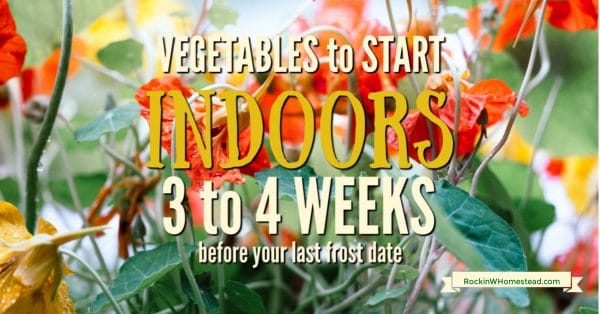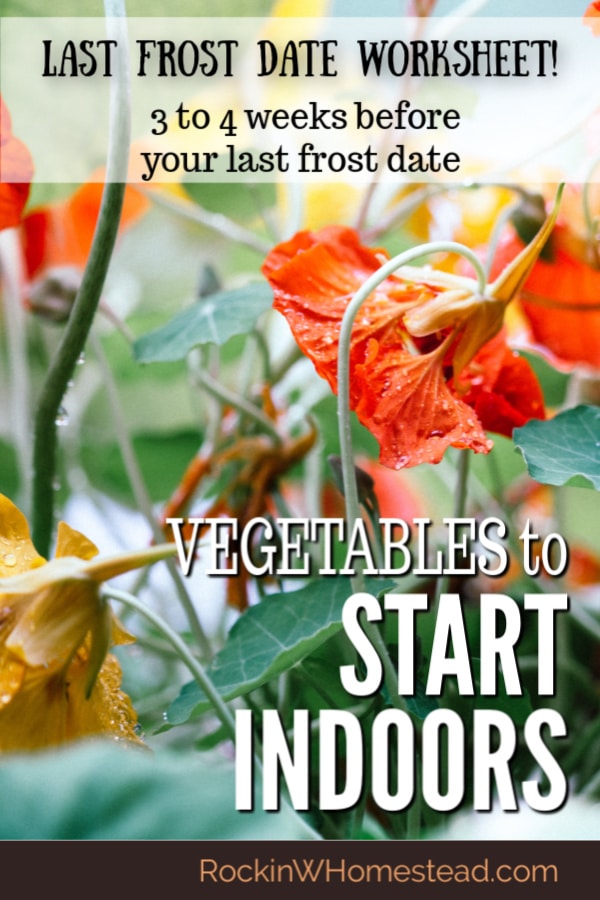Which vegetables should be planted indoors 3 to 4 weeks before your last frost date? The warm weather crops are coming into view and will be ready for transitioning your garden for the hot weather ahead.

If you’ve been following this series you’ll know that we have mostly talked about all the cool weather crops that have blessed your garden so far. The vegetables that are ready to be started in this batch are all the warm weather plants that will grace your garden for the bulk of the warm summer season.
Get a jump on these plants indoors so your harvest will be quick and abundant. The plants in this list cannot take even a bit of cold weather, so be sure that they are not set out until all danger of frost has passed and the soil has warmed appropriately.
Other articles in the “what to plant indoors” series
What to plant indoors 8 to 12 weeks before your last frost date
What to plant indoors 6 to 8 weeks before your last frost date
What to plant indoors 4 to 6 weeks before your last frost date
What to plant indoors 3 to 4 weeks before your last frost date
Cucumber can be grown as a bush or trellis as a vine crop, depending on the variety you choose. start early indoors so you can enjoy them with your early salad greens. Soil temperatures must be at least 60F for germination.
Lettuce is quick growing and requires very little effort. Plant loose-leaf varieties in plastic tub indoors and move them outside as soon as temperatures reach 65 to 70F. Placing the seeds in the refrigerator for 5 days will speed germination.
Okra is a warm-weather crop that is easy to grow. Direct seed after soil temperatures reach 60F, or in cool climates start indoors before transplanting.
Cantaloupe, Musk Melon, and Watermelon have a long 110 day season and require a temperature above 60F at night and 80F+ during the day. Northern gardeners will find that they can be grown in raised beds when using dark plastic mulch to heat the soil. Start the seeds indoors to get a jump
Mustard Greens come in all leaf varieties and are a short season crop that can be planted outside as soon as danger of frost has passed. Useful in soup and salads, they are packed full of vitamins, with 524% of the daily requirement of Vitamin K, 177% of the daily requirement of Vitamin A, and 59% of the daily requirement for Vitamin C.
Pumpkin and Winter Squash can be planted indoors, but do not like to have their roots disturbed when transplanting out. Consider planting in peat pots or make your own pots from recycled paper.
Spinach and Swiss Chard are quick growing plants like lettuce and once established, will take a light frost. Start in plant packs or plastic tubs and plant outside as soon as the soil can be worked.
Summer Squash come in bush and vining varieties and do not like cool weather. For the best success take care with roots as when planting winter squash and transplant to mounds or rows after all danger of frost has passed.
Basil is not a vegetable but still a standard herb in every kitchen garden. They will not tolerate any cold. Self-seeding is possible from last years crop, however for the earliest harvest, starting the seed indoors is a must.
How do I know my last frost date?
I’ve created a handy worksheet to help you determine your last frost date and how to use this to know when you should start specific seeds indoors. This will also help you decide on the best time to plant them outside in the garden.
Get the Frost Date Planting Worksheet
Don’t worry if you’ve missed the seed starting date, there is often still a window of time to get started. If it is not too far gone, start the seeds anyway. Most cool-weather crops can be planted in succession until the days get very hot during the summer months.
If it is getting on in the season, purchasing starts from the local nursery may be your best option this year.
The Last Frost Date Planting Worksheet works to help you know when to plant certain vegetables and herbs in your garden without danger of frost damage. Enjoy!
Now that you’ve determined your last frost date, what should you be planting right now 3 to 4 weeks before last frost date?



[…] What to plant 3 to 4 weeks before your last frost date […]